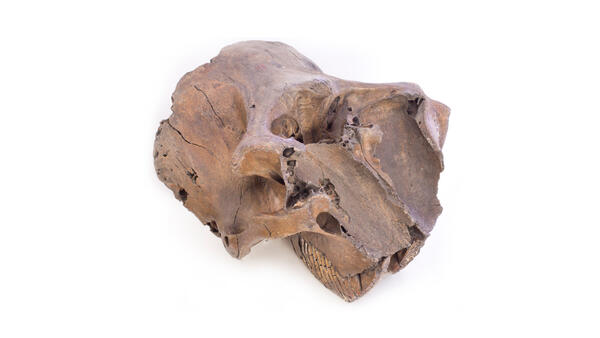The woolly mammoth skull is kept in the Regional Museum of Local History collection. This mammoth lived on the modern territory of the Republic of Yakutia more than 6000 years ago. The exhibit became part of the collection in 1883.
The mammoths are extinct animals of the Elephantidae family; they first appeared in Africa about five million years ago. The most famous species is the woolly mammoth, which appeared in Siberia from 300 to 200 thousand years ago, and then spread to Europe and North America. German scientist Johann Friedrich Blumenbach in 1799 made the first scientific description of the ‘Siberian species’.
The mammoths were among the largest inhabitants on the planet: their height could reach four meters, and the weight — up to eight tons. The mammoth tusks separately weighed up to 100 kilograms. The color of the coat varied from brown to yellow-brown, and the length of a single hair reached almost a meter. The thick undercoat protected the mammoths from the cold.
These prehistoric animals ate grass, leaves and tree branches. The mammoths had only four teeth — two on each side. Therefore, they did not chew, they would grind the food and then swallow it. Mammoths used their tusks in winter to clear the snow and to find food, and also to break the ice to have a drink.
Scientists suggest, that the oldest female was the leader in the herd; the same hierarchy is established among modern elephants. Most often, male mammoths kept to themselves and joined herds only during the mating season.
Why the mammoths became extinct is still unknown. Scientists suggest two main reasons: climate change and the early human hunters, who began actively develop new weapons during this time.
The mammoths did not go extinct abruptly: different species on different continents faded away gradually. The American mammoth became extinct 8-10 thousand years ago, while the Eurasian mammoths did a little earlier. The mammoths, that lived on Wrangel Island went extinct about 4 thousand years ago, and dwarf elephants lived up until the beginning of the Holocene epoch. Their remains, found on the Greek island of Tilos, date back to about 2000 BC.
The mammoths are extinct animals of the Elephantidae family; they first appeared in Africa about five million years ago. The most famous species is the woolly mammoth, which appeared in Siberia from 300 to 200 thousand years ago, and then spread to Europe and North America. German scientist Johann Friedrich Blumenbach in 1799 made the first scientific description of the ‘Siberian species’.
The mammoths were among the largest inhabitants on the planet: their height could reach four meters, and the weight — up to eight tons. The mammoth tusks separately weighed up to 100 kilograms. The color of the coat varied from brown to yellow-brown, and the length of a single hair reached almost a meter. The thick undercoat protected the mammoths from the cold.
These prehistoric animals ate grass, leaves and tree branches. The mammoths had only four teeth — two on each side. Therefore, they did not chew, they would grind the food and then swallow it. Mammoths used their tusks in winter to clear the snow and to find food, and also to break the ice to have a drink.
Scientists suggest, that the oldest female was the leader in the herd; the same hierarchy is established among modern elephants. Most often, male mammoths kept to themselves and joined herds only during the mating season.
Why the mammoths became extinct is still unknown. Scientists suggest two main reasons: climate change and the early human hunters, who began actively develop new weapons during this time.
The mammoths did not go extinct abruptly: different species on different continents faded away gradually. The American mammoth became extinct 8-10 thousand years ago, while the Eurasian mammoths did a little earlier. The mammoths, that lived on Wrangel Island went extinct about 4 thousand years ago, and dwarf elephants lived up until the beginning of the Holocene epoch. Their remains, found on the Greek island of Tilos, date back to about 2000 BC.



